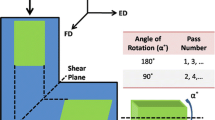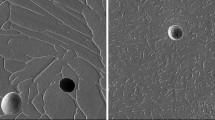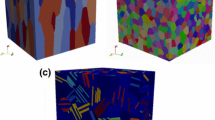Abstract
Ductility of three titanium alloys was evaluated after exposure to time and temperature conditions representative of superplastic forming (SPF). Following exposure, flexural specimens were postprocessed to remove the α-case by one of three methods: no material removed, the standard amount of material removed by chemical processing, or a reduced amount of material removed also by chemical processing. Results include the evaluation of the specimens per ASTM E 290-97a and AMS-T 9046, springback analysis, and prediction of minimum bend radius criteria for the three alloys from finite element method simulation. It was found that results varied based on alloy and exposure temperature and the reduced postprocessing of titanium SPF parts produced acceptable results under certain conditions.
Similar content being viewed by others
References
R.J. Tisler and R.J. Lederich, Advanced Superplastic Titanium Alloys, Titanium ’95 Science and Technology, Proceedings of the Eight World Conference on Titanium, P.A. Blenkinsop, W.J. Evans, H.M. Flowers, Ed., The Institute of Materials, 1995, p 596–603
W.D. Brewer, R.K. Bird, and T.A. Wallace, Titanium Alloys and Processing for High Speed Aircraft, Mater. Sci. Eng., Vol A243, 1998, p 299–304
P.N. Comley, Aerospace Part Production Using SP700, Mater. Sci. Forum, Vol 357–359, 2001, p 41–46
F. Pitt, “Influence of Time, Temperature and Alloy on Oxygen Absorption in SPF Titanium,” University of Washington, 2000
L.J.H. Brasche and O. Buck, Nondestructive Methods for Determination of Mechanical Properties of Aluminum and Titanium Alloys, Review of Progress in Quantitative Nondestructive Evaluation, Vol 10B, D.O. Thompson and D.E. Chimenti, Ed., Plenum Press, 1991, p 1701–1706
A.I. Kahveci and G.E. Welsch, Hardness versus Strength Correlation for Oxygen-Strengthened Ti-6Al-4V Alloy, Scr. Metall. Mater., Vol 25, 1991, p 1957–1962
R.J. Tisler, “Advanced Superplastic Titanium Alloys,” presented at the Annual Corporate Technology Conference Advanced Materials & Structures Technology Session, McDonnell Douglas Aerospace (Long Beach, CA), May 18, 1995
“Ti-6Al-4V Material Specification,” AMS-T-9046, AB-1, Society of Automotive Engineers, 1999
“Ti 6-2-2-2-2 Material Specification,” AMS 4898, Titanium Alloy, Sheet, 6Al-2Sn-2Zr-2Mo-2Cr-0.15Si, Annealed, Society of Automotive Engineers, 1996
“SP 700 Material Specification,” AMS 4899, Titanium Alloy, Sheet, Strip, and Plate, 4.5Al-3V-2Fe-2Mo, Annealed, Society of Automotive Engineers, 1996
V. Nagpal, T.L Subramanian, and T.A. Altan, “ICAM Mathematical Modeling of Shear Metal Formability Indices and Sheet Metal Forming Processes”, Technical Report AFML-TR-79-4168, AFML/LTC, Wright Patterson Air Force Base (WPAFB), 1979
Author information
Authors and Affiliations
Rights and permissions
About this article
Cite this article
Pitt, F., Ramulu, M., Labossiere, P. et al. Postprocessing effect on the ductility and flexural behavior of three titanium alloys under simulated superplastic forming conditions. J. of Materi Eng and Perform 13, 735–743 (2004). https://doi.org/10.1361/10599490421565
Received:
Issue Date:
DOI: https://doi.org/10.1361/10599490421565




